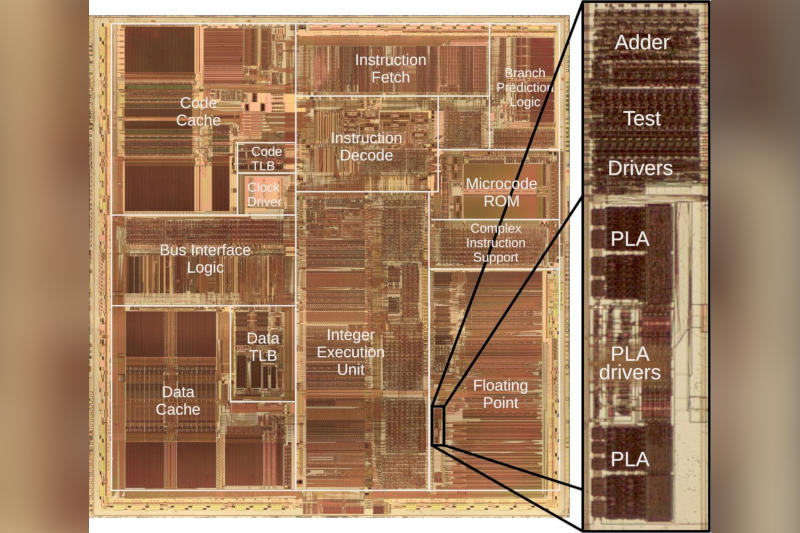Engineer finds transistors in Pentium processor that cost Intel $475 million 30 years ago


Electronics history and reverse engineering specialist Ken Shirriff said he was able to discover transistors in the first generation Intel Pentium processors that caused the “FDIV error” that cost the manufacturer $475 million in 1994.


Image source: oldbytes.space/@kenshirriff
The FDIV (Floating Point Division) bug was that processors did not correctly perform the division operation of floating point numbers. The expert armed himself with a microscope and examined the programmable logic array (PLA) responsible for this error. The Intel Pentium processor based on the P5 architecture was manufactured using the 800 nm process technology – the crystal contains 3.1 million transistors, and their arrangement can actually be studied under a microscope and the blocks of operations on the chip can be identified. With modern processors, which have tens of billions of transistors, this is impossible.
The floating point unit on Pentium processors was faster than on chips of the time, thanks to the SRT division algorithm, which allowed division at a rate of two bits per clock. In order for it to function correctly, a table of 2048 cells with the values “-2”, “-1”, “0”, “1” and “2” was placed on the chip in 112 rows. The values were expressed by the presence or absence of transistors in the cells. But five table entries were missing important transistors, resulting in default values of “0” instead of the correct “2”. This caused floating point calculations to produce incorrect results.
The FDIV error was discovered by Lynchburg College mathematics professor Thomas R. Nicely, but Intel initially called it insignificant and said that it could only occur once every 27 thousand years. IBM, however, determined that it could occur every 24 days and stopped selling Pentium processors. As a result, Intel recalled all processors and suffered a loss of $475 million. It is noteworthy that as a result of the study, Shirriff revealed the absence of not 5 data points, as previously assumed, but 16, and 11 not previously detected did not cause errors “by pure luck,” the engineer noted . Intel ended up quickly fixing the bug by filling all the unused entries on the boards with “2” values, and it worked.
Recent Posts
Elon Musk’s Efforts Cause IBM to Lose Millions in Contracts, Still Beats Analysts’ Expectations for the Quarter
IBM reported financial results for the first quarter of 2025, which ended March 31. Although…
DeepCool CG580 Case: Maximum Functionality, Minimum Cost
Following the recently tested CH690 Digital, today we will get acquainted with another DeepCool case…
Razer Releases Its First Mouse With A Hand-Grip — The Pro Click V2 Vertical Edition
Razer has announced two new mice in its Pro Click lineup — the standard Pro…
- Mobile phones, smartphones, cellular communications, communicators, PDAs
- Technology and IT market. news
Motorola unveils flagship Razr 60 Ultra flip phone and cheaper Razr 60 version — both with dust protection
Motorola has unveiled its next generation of 2025 foldable smartphones, the Razr 60 Ultra and…
Quantum silicon processors are coming — Australian startup entangles quantum ‘transistors’ for the first time
Australian startup Diraq has published an article in Nature Communications, in which it has for…
- Mobile phones, smartphones, cellular communications, communicators, PDAs
- Technology and IT market. news
Motorola Unveils Powerful Edge 60 and Edge 60 Pro Smartphones with Capacious Batteries and Pantone Displays
Motorola has unveiled the Edge 60 and Edge 60 Pro, smartphones with curved 6.7-inch displays…